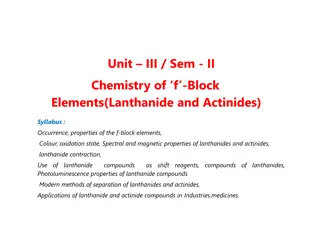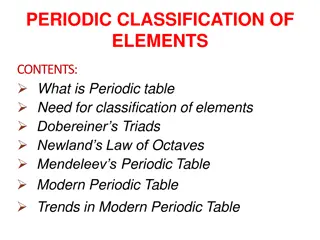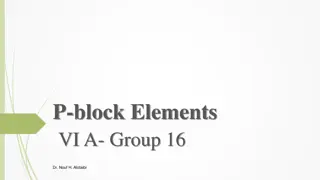Diagonal Relationship in S-Block Elements: Similarities and Properties
A diagonal relationship exists between adjacent elements in the second and third periods of the periodic table, showcasing similarities in properties. Elements like lithium, magnesium, beryllium, and aluminum exhibit distinct characteristics and behaviors with comparisons provided. Explore the unique trends and correlations among s-block elements in this informative overview.
Download Presentation

Please find below an Image/Link to download the presentation.
The content on the website is provided AS IS for your information and personal use only. It may not be sold, licensed, or shared on other websites without obtaining consent from the author.If you encounter any issues during the download, it is possible that the publisher has removed the file from their server.
You are allowed to download the files provided on this website for personal or commercial use, subject to the condition that they are used lawfully. All files are the property of their respective owners.
The content on the website is provided AS IS for your information and personal use only. It may not be sold, licensed, or shared on other websites without obtaining consent from the author.
E N D
Presentation Transcript
Shahid ShahidVirpatni Virpatni Laxmi Mahavidyalaya,Titave Mahavidyalaya,Titave Laxmi Department of Science Miss.Kajal Prakash Balugade Assistant Professor Inorganic Chemistry
Diagonal Relationship within s Block Elements
Adiagonal relationship in s block elements exists between adjacent elements, which are located in the second and third periods of the periodic table. For example, the lithium of group 1A and the second period shows similarities with the properties of magnesium, which are located in the 2nd group and 3rd period. Similarly, the properties of beryllium, which are located in the 2nd group and 2nd periods, show a likeness with the properties of aluminium which is located in the third period and third group. The two elements which show similarities in their properties can be called diagonal pairs or diagonal neighbors.
The properties of s block elements vary significantly when compared to the other elements of the sub-group they belong to. The diagonal neighbors show a lot of similarities. Such a relationship is exhibited as you move left to the right and down the group; the periodic table has opposing factors. For example, the electronegativity of the s block elements increases as we go across the period and decreases as we go down the group. Therefore, when it is moved diagonally, the opposite tendencies cancel out, and the value of electronegativity almost remains the same.
Similarities between Lithium and Magnesium The hardness of lithium and magnesium is higher than the other elements in their respective groups. Chlorides of lithium and magnesium have the capability to be soluble in ethanol. They are lighter when compared to other elements in their groups. Lithium and magnesium react gently with water. The oxides and hydroxides are less soluble.
In the presence of nitrogen, lithium and magnesium form their respective nitrides. Superoxides are not formed when lithium and magnesium react with excess oxygen. Carbon dioxide and its respective oxides are formed when carbonates of magnesium and lithium are heated
Similarities between Beryllium and Aluminium Aluminium hydroxide and beryllium hydroxide react with excess alkali to form their respective ions. Both these elements have the capacity to withstand the acid attack due to the presence of an oxide film on the surface of the metal. Both these metals have the tendency to form complexes. Chlorides of both these metals possess the capacity to be soluble in organic solvents.
Thank You Thank You























